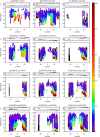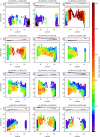Global Vertical Distribution of Water Vapor on Mars: Results From 3.5 Years of ExoMars-TGO/NOMAD Science Operations
- PMID: 36583097
- PMCID: PMC9787519
- DOI: 10.1029/2022JE007231
Global Vertical Distribution of Water Vapor on Mars: Results From 3.5 Years of ExoMars-TGO/NOMAD Science Operations
Abstract
We present water vapor vertical distributions on Mars retrieved from 3.5 years of solar occultation measurements by Nadir and Occultation for Mars Discovery onboard the ExoMars Trace Gas Orbiter, which reveal a strong contrast between aphelion and perihelion water climates. In equinox periods, most of water vapor is confined into the low-middle latitudes. In aphelion periods, water vapor sublimated from the northern polar cap is confined into very low altitudes-water vapor mixing ratios observed at the 0-5 km lower boundary of measurement decrease by an order of magnitude at the approximate altitudes of 15 and 30 km for the latitudes higher than 50°N and 30-50°N, respectively. The vertical confinement of water vapor at northern middle latitudes around aphelion is more pronounced in the morning terminators than evening, perhaps controlled by the diurnal cycle of cloud formation. Water vapor is also observed over the low latitude regions in the aphelion southern hemisphere (0-30°S) mostly below 10-20 km, which suggests north-south transport of water still occurs. In perihelion periods, water vapor sublimated from the southern polar cap directly reaches high altitudes (>80 km) over high southern latitudes, suggesting more effective transport by the meridional circulation without condensation. We show that heating during perihelion, sporadic global dust storms, and regional dust storms occurring annually around 330° of solar longitude (L S) are the main events to supply water vapor to the upper atmosphere above 70 km.
© 2022. The Authors.
Figures














References
-
- Alday, J. , Trokhimovskiy, A. , Irwin, P. G. J. , Wilson, C. F. , Montmessin, F. , Lefèvre, F. , et al. (2021). Isotopic fractionation of water and its photolytic products in the atmosphere of Mars. Nature Astronomy, 5(9), 943–950. 10.1038/s41550-021-01389-x - DOI
-
- Aoki, S. , Daerden, F. , Viscardy, S. , Thomas, I. R. , Erwin, J. T. , Robert, S. , et al. (2021). Annual appearance of hydrogen chloride on Mars and a striking similarity with the water vapor vertical distribution observed by TGO/NOMAD. Geophysical Research Letters, 48(11), e2021GL092506. 10.1029/2021GL092506 - DOI
-
- Aoki, S. , & Vandaele, A. C. (2022). Global vertical distribution of water vapor on Mars retrieved from 3.5 years of TGO/NOMAD science operations, presented in Aoki et al., 2022. Royal Belgian Institute for Space Aeronomy. 10.18758/71021072 - DOI
-
- Aoki, S. , Vandaele, A. C. , Daerden, F. , Villanueva, G. L. , Liuzzi, G. , Thomas, I. R. , et al. (2019). Water vapor vertical profiles on Mars in dust storms observed by TGO/NOMAD. Journal of Geophysical Research: Planets, 124(12), 3482–3497. 10.1029/2019JE006109 - DOI
-
- Belyaev, D. A. , Fedorova, A. A. , Trokhimovskiy, A. , Alday, J. , Montmessin, F. , Korablev, O. I. , et al. (2021). Revealing a high water abundance in the upper mesosphere of Mars with ACS onboard TGO. Geophysical Research Letters, 48(10), e2021GL093411. 10.1029/2021GL093411 - DOI
LinkOut - more resources
Full Text Sources
Miscellaneous
